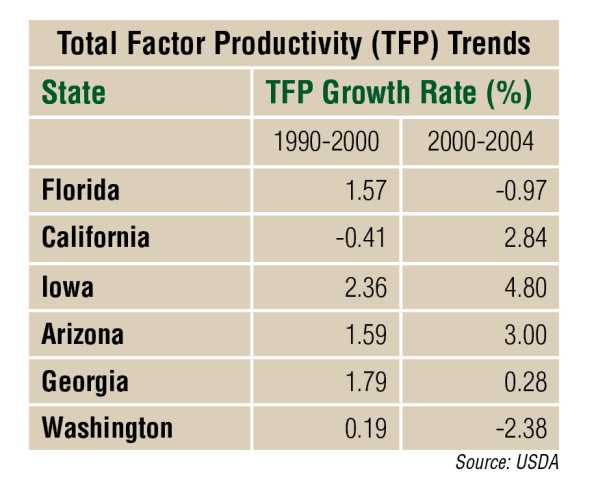U.S. Farm Productivity Approaching Perilous Ground
USDA publishes reports on Total Factor Productivity (TFP), a measure of production relative to the volume of inputs used to grow that production.
Traditionally, farmers have thought about productivity in terms of yield per acre or production per animal. TFP takes it a step further by accounting for all of the land, labor, capital, and material resources employed to produce the crop and livestock in the agricultural sector.
Since 1960, Florida has ranked first or second (only to California) in those calculations. But most troubling in the published state level data are the numbers for the latest period of 2000 to 2004, which shows negative growth in productivity of negative 0.97% for Florida. There are only eight states that experienced negative growth in TFP over that period (Florida, Kentucky, Maine, North Carolina, North Dakota, Virginia, Washington, and West Virginia).
 Counting Up Costs
Counting Up Costs
Of even more concern is that Florida growers are spending more on inputs without any response in total production since 2004, indicating the negative growth rate is likely continuing for our farmers. It begs the question: Is this an aberration or is this additional insight into the future of some important agricultural industries in Florida?
It should be no surprise the input where we have seen the greatest rise in use nationally is pesticides with annual growth rates in use of 4.3% in the 1990 to 2000 period, 8.2% in the 2000 to 2007 period, and 5.3% from 2007 to 2013.
While Florida still sits near the top in TFP, the more recent signs beg action on the part of the industry. With continued negative growth in TFP, Florida is certain to see a decline of agricultural production and a conversion of land into other more profitable uses, like development. There is little doubt Florida’s negative TFP growth continued from 2004 to the current time. Vegetable and citrus growers have all seen it become more difficult to compete.
A Global Gap
What also should be noted by producers and policymakers is the comparison of productivity growth in the U.S. as compared to some other critical countries. Brazil at 3.74% growth in TFP and Mexico at 2.74% growth have made greater strides in productivity since 1961 than all other countries the U.S. is compared against.
Are we investing enough in research and extension to maintain our edge in productivity against countries with who we compete? These results suggests we are not making timely investments in research and development, or we are not getting the lead in implementing the advances in science we are making.
There is some light in the data, however. Increased productivity from capital investments has resulted in TFP growth in the last decade. Increased use of labor and material inputs has not resulted in higher productivity, but capital investment has given some hope there is a light out there.










